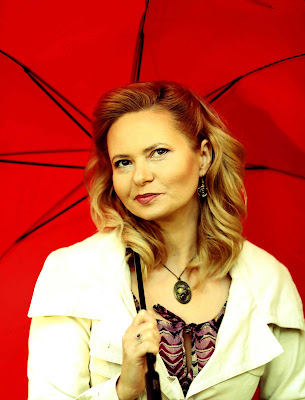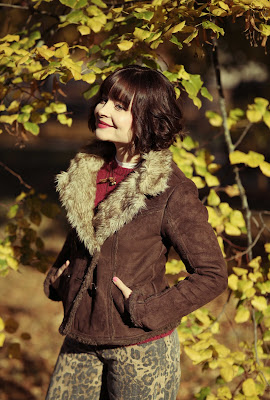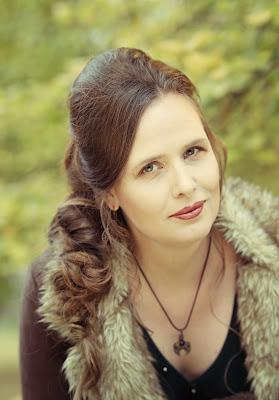Polecany post
Włosy kręcone - jak je ujarzmić?
Jak prostować włosy? Jest klika sposobów aby włosy kręcone lub puszące się i niesforne zamienić na proste i gładkie. Najbardziej z...

poniedziałek, 7 lipca 2025
piątek, 4 lipca 2025
Rzeźba w glinie pomalowana akrylami imitując mosiądz
Zapraszam na Warsztaty Artystyczne w soboty o 14 i poniedziałki o 18.
Kontakt: 22 743 01 20
Grupa fb: https://www.facebook.com/groups/592291043593760
wtorek, 15 kwietnia 2025
niedziela, 13 kwietnia 2025
Warsztaty Artystyczne
Zapraszam na Warsztaty Artystyczne:
Soboty: 14:00-17:00
Poniedziałki: 18:00-21:00
Kontakt: 22 743 01 20
wtorek, 11 marca 2025
Ile kalorii spala malowanie? Czy warto malować?
Malowanie i rysowanie wspierają rozwój motoryczny, kreatywność, wyobraźnię oraz ekspresję emocjonalną.
Dzięki tym formom twórczej zabawy, uczymy się koncentracji, cierpliwości i budujemy poczucie własnej wartości.
Poszukałam w necie i jest: 30 minut malowania dla osoby o wadze 70 kg to 186 kcal, a dla osoby ważącej 84 kg – 222 kcal. Jeśli 80 kg mężczyzna pójdzie na 3km spacer, idąc z prędkością 3 km/h, spali 160 kcal . Wybór jest prosty.
Malowanie rozwija zdolności poznawcze, pobudza zmysł obserwacji, wspiera rozwój inteligencji emocjonalnej, rozwija wrażliwość, poczucie estetyki, relaksuje i odpręża. W czasie rysowania, w korze przedczołowej, połączonej z funkcjonowaniem układu nagrody, zwiększa się przepływ krwi, czyli poprawia samopoczucie psychiczne.
Podczas procesu twórczego uwalniasz serotoninę, endorfiny i noradrenalinę. W trakcie malowania wydziela się oksytocyna i dopamina, czyli związki chemiczne. które wpływają na dobry nastrój, rozwijają kreatywność i zmniejszają stany lękowe. Zajęcia artystyczne znacząco obniżają poziom kortyzolu, czyli hormonu stresu.
Głównym zadaniem kortyzolu jest regulacja odpowiedzi organizmu na stres – zwiększanie stężenia glukozy we krwi w sytuacjach stresowych (wysiłek fizyczny, stres psychiczny, głodzenie), gdy w szczególności wzrasta na nią zapotrzebowanie.
Oksytocyna daje poczucie odprężenia, poprawia samopoczucie, sprawia, że stajemy się bardziej empatyczni, lepiej współpracujemy, mamy większe zaufanie do innych osób.
Noradrenalina
pobudza obszary mózgu, stąd też sprzyja m.in. lepszej koncentracji,
przypominaniu sobie faktów, zdarzeń, informacji oraz zwiększa czujność i
uważność.
Endogenne morfiny, czyli endorfiny, to hormony peptydowe, które wywołują uczucie zadowolenia i szczęścia, a także odpowiedzialne są za stany euforyczne. Ich duża koncentracja we krwi zmniejsza odczuwanie bólu.
Serotonina to neuroprzekaźnik, czyli substancja, która przenosi informacje w układzie nerwowym.
Dopamina to związek chemiczny, który pełni rolę neuroprzekaźnika w ośrodkowym układzie nerwowym. Jest odpowiedzialna za regulowanie wielu funkcji, w tym nastroju, motywacji, przyjemności, a także koordynacji ruchowej i ciśnienia tętniczego krwi.
Zapraszam:
SOBOTY o godz. 14 na Warsztaty Artystyczne z Aga G
Informacje organizacyjne w grupie fb: Warsztaty Artystyczne
Kontakt: 22 743 01 20
wtorek, 4 marca 2025
Wypadanie włosów - Co robić?!!!
Dziennie wypada nam do 100 włosów
i na to miejsce wyrastają nowe. Jest to proces zupełnie naturalny.
Czasem jednak uszkodzony mieszek na ich miejsce
nie produkuje kolejnych. I co wtedy możemy zrobić?
W okresie wiosennym i jesiennym zauważamy zwiększone wypadanie włosów związane z brakiem witamin i osłabieniem organizmu. Jest to naturalne w naszym klimacie. Aby temu zapobiegać należy do diety dołączyć więcej warzyw bogatych w siarkę, jak papryka, cebula i czosnek, suplementy z biotyną, ograniczyć stres oraz masażami głowy poprawić krążenie.
Problem nadmiernego wypadania włosów dotyczy nie tylko mężczyzn ale to oni odczuwają go najbardziej dotkliwie. Kobiety mają więcej sposobów na jego ukrywanie. Mężczyźnie nie przystoi noszenie peruk czy dodatków do włosów w postaci chust itp. Tak zwany typowy mężczyzna wyznaje również zasadę, że skoro coś służy do kąpieli to można tym umyć również włosy. I tu zaczynają się problemy z utrzymaniem właściwego stanu skóry głowy oraz włosów.
Jeśli zauważymy u siebie nadmierne wypadanie włosów bardzo ważne jest określenie czy wypadają one u nasady czy też łamią się i kruszą. W tym celu należy przesunąć palcami delikatnie po całej długości włosa, który znaleźliśmy. jeśli na końcu wyczujemy zgrubienie oznacza to, że włosy wypadają z cebulkami. Wtedy należy zadbać także o skórę głowy. Świetnie sprawdzają się wcierki, suplementy diety z biotyną i ampułki zapobiegające wypadaniu włosów. Ważne jest również dostosowanie naszej diety, zwiększenie ilości witamin oraz produktów zawierających siarkę, takich jak cebula, czosnek czy papryka.
Wypadanie włosów jest częstym wskaźnikiem nadmiernego stresu lub różnych jednostek chorobowych. Ponieważ nasz organizm postrzega włosy jako coś zbędnego, w momencie kryzysowym wykorzystuje witaminy i składniki odżywcze w innych, bardziej niezbędnych częściach ciała z punktu widzenia przetrwania. Właśnie dlatego należy do tego problemu podejść holistycznie. Zazwyczaj polecam wtedy profilaktyczne badania tarczycy, ponieważ wszelkie zmiany hormonalne zawsze wpływają na stan włosów. Zupełnie naturalne jest nadmierne wypadanie włosów po ciąży i okresie karmienia. W czasie ciąży gospodarka hormonalna jest zaburzona i organizm wstrzymuje normalne wypadanie włosów, dlatego też później wypada ich więcej w krótszym czasie. Podobnie jest w przypadku zastosowania znieczulenia podczas zabiegów chirurgicznych czy chemioterapii. Organizm przeżywa szok i poświęca wszystkie dostępne środki na regenerację. Możemy wtedy zadbać o odpowiednią dietę dostarczając maksymalną ilość składników odżywczych, ograniczyć stres i zadbać o skórę głowy. Bardzo dobrze na jej rozluźnienie i poprawienie krążenia działają masaże.
Jeśli włosy nie wypadają z cebulkami, a jedynie łamią się i kruszą niezbędne jest zastosowanie odżywek regenerujących i wzmacniających włókno włosa. Zazwyczaj polecam Cement z Kerastase ponieważ jest bardzo skuteczny w odbudowie struktury i domykaniu łusek. Powstrzymuje to wrażliwość i łamliwość, a tym samym zapobiega dalszej utracie włosów.
Kiedy wypadanie włosów ma natomiast podłoże genetyczne lub silne zmiany hormonalne zawsze odsyłam do specjalistów. Ponieważ łysienie z łaciny alopecia jest to objaw chorobowy, polegający na
postępującym zanikaniu wytwarzania włosa w mieszku włosowym. Cebulki
włosów stają się mniejsze, a mieszek włosowy ulega osłabieniu. Dlatego
włosy zaczynają wypadać szybciej i na ich miejsce wyrastają nowe, o
wiele słabsze i cieńsze. Proces ten dotyczy włosów na głowie, aczkolwiek
nie wszystkie obszary głowy są na niego podatne w jednakowym stopniu.
Dlatego zazwyczaj pojawiają się zakola lub włosy tracą gęstość na czubku
głowy. Najczęściej występującym typem łysienia jest łysienie
androgenowe. Jest ono spowodowane wrażliwością mieszka włosowego na
pochodną testosteronu. (Tu odpowiedź na częste pytanie - Tak, podwyższony poziom testosteronu ma związek ze stanem włosów) Pod jego wpływem mieszek włosowy wytwarza coraz
cieńsze i słabsze włosy, sam jednocześnie ulegając zmniejszeniu. Na
koniec tego procesu mieszek wytwarza już tylko krótki włos pozbawiony
barwnika. Aby temu zaradzić konieczne jest działanie mające na celu
wzmocnienie mieszka włosowego.
Jest wiele preparatów dostępnych na
rynku, które wzmacniają mieszki i cebulki włosów. Z własnego
doświadczenia polecić mogę Aminexil. Jest to środek opracowany przez
Koncern L'Oreal przeciwko łysieniu, w którym kopexil (pod nazwą
aminexil) jest substancją czynną. Wstępne badania kliniczne wykazały
spadek odsetka włosów w fazie spoczynkowej (telogenowej) i znaczący
wzrost udziału włosów w fazie wzrostowej (anagenowej).Czyli proces
obumierania i osłabiania mieszków włosowych został zahamowany.
Jednocześnie nastąpił znaczny wzrost liczby włosów rosnących prawidłowo,
mocniejszych i grubszych. Prawdopodobną przyczyną skuteczności kopexilu
jest zwiększenie przeżywalności mieszków włosowych. Dzieje się to
wskutek zahamowania tworzenia kolagenu wokół mieszków. Kolagen osłabia
cebulkę i prowadzi do wypadania włosów wcześniej niż trwa ich średni
okres wzrostu. Wydłużenie ,,żywotności'' włosów wynika z właściwości
przeciwwłóknieniowych kopexilu.
Łysienie, jako stan chorobowy może być objawem niektórych dolegliwości,
reakcją organizmu na przyjmowane leki bądź stanowić samodzielny zespół
chorobowy. Ze względu na cechy genetyczne pacjenta może być też stanem
dziedziczonym. Określenie konkretnych przyczyn łysienia możliwe jest po
uprzednim zbadaniu stanu zdrowia pacjenta. Nie istnieje jedna,
uniwersalna przyczyna powodująca wystąpienie choroby. Wśród najczęściej
występujących czynników chorobotwórczych wymienia się stosowanie
niektórych leków, promieniowanie jonizujące, zatrucie metalami ciężkimi,
uwarunkowania genetyczne, niektóre choroby, czynniki stresogenne,
zmiany hormonalne, niedobory pokarmowe, zaniedbania higieniczne oraz
zbyt intensywne lub zbyt często stosowane zabiegi kosmetyczne.
Ponieważ nie ma jednej przyczyny nadmiernego wypadania włosów, nie ma
również idealnego środka, działającego w każdym przypadku. Jednak
działania profilaktyczne oraz właściwa pielęgnacja skóry głowy i włosów w
znacznym stopniu ograniczą ten problem lub zwalczą go całkowicie. Ponieważ o wiele łatwiej jest przeciwdziałać niż leczyć pamiętajmy o naszych włosach na co dzień. Jeśli dostrzegamy początkowe objawy nadmiernego wypadania włosów skonsultujmy się z naszym fryzjerem i dermatologiem.
środa, 5 lutego 2025
Warsztaty Artystyczne - Bon Prezentowy
Szukacie pomysłu na PREZENT?
Zapraszam na Warsztaty Artystyczne.
Kontakt: 22 743 01 20
niedziela, 2 lutego 2025
Prezent Walentynkowy - WARSZTATY ARTYSTYCZNE
Jeśli szukacie pomysłu na prezent WALENTYNKOWY zapraszam na wspólne malowanie w salonie. Możecie skorzystać z BONÓW PREZENTOWYCH indywidualnie lub zapisać się na cykliczne Warsztaty Artystyczne.
WARSZTATY ARTYSTYCZNE odbywają się w każdą sobotę o godzinie 14:00 w salonie ART -AGE (PASAŻ MURANÓW: Al. Jana Pawła II 43A, lokal 29B, poziom -1) Strona fb: ART-AGE Salon Fryzjerski Warszawa
Temat: Malowanie obrazu farbami akrylowymi na płótnie.
Cena: 50zł
Kontakt: 22 743 01 20
Link do grupy fb: WARSZTATY ARTYSTYCZNE
środa, 11 grudnia 2024
2025 trends
Here is my styling proposal for the New Year 2025!This season, natural colors and ethnic patterns will dominate. Animal patterns, fur and spots are coming back into favor.
We tie our hair into loose and elegant styles. Such buns, delicate updos or braids are perfect for more or less formal New Year's Eve parties. They emphasize our beauty and hide any shortcomings. Due to their natural character, they do not add years, but actually reduce them.
Waves and curls add volume and allow for artistic disorder. This hairstyle adds lightness and naturalness. Moreover, it gently rejuvenates, while having that girlish charm.
Hair in natural shades will perfectly match earth-colored styling and ethnic or animal patterns.
Maku-up, hair colors and updos, styling, direction and organization of the session and photo editing: Aga G
Photo: G.Hucz
wtorek, 10 grudnia 2024
Trendy 2025
Oto moja propozycja stylizacji na Nowy Rok 2025!
W tym sezonie królować będą naturalne kolory oraz wzory etniczne. Na powrót do łask wracają zwierzęce wzory, futra i cętki.
Włosy upinamy w luźne i eleganckie stylizacje. Takie koki, delikatne upięcia czy warkocze są idealne na bardziej lub mniej formalne imprezy Sylwestrowe. Podkreślają nasze piękno i ukrywają wszelkie mankamenty. Przez swój naturalny charakter nie dodają lat, a wręcz ujmują.
Fale i loki dodają objętości i pozwalają na artystyczny nieład. Taka fryzura dodaje lekkości i naturalności. Ponadto delikatnie odmładza, mając w sobie ten dziewczęcy urok.
Włosy w naturalnych odcieniach idealnie dopasują się do stylizacji w kolorze ziemi oraz etnicznych czy zwierzęcych wzorów.
Jako dodatki najlepiej sprawdzą się kamienie szlachetne i metale.
Biżuteria w kolorach miedzi, brązu i fioletu w naturalny sposób dopełni etniczne stylizacje.
Maku-up, kolory i upięcia włosów, stylizacja, reżyseria i organizacja sesji oraz edycja zdjęć: Aga G
Foto: G.Hucz
piątek, 20 września 2024
Superfood - red beets
Red beets are easily digestible, low-calorie and do not cause allergies. They contain vitamins: C, A, E, K and minerals: calcium,iron, magnesium, phosphorus, potassium, sodium, zinc and folic acid.Pickled beets (kiszone) strengthen the blood and improve the composition of the intestinal flora, thanks to which the functioning of the digestive system and metabolism will be improved. They have bactericidal and anti-inflammatory effects. They have a positive effect on our nervous system and stimulate the development of gray cells.
The easiest way to prepare pickled (kiszone) beets is with salt, garlic and water.
-red beets
-2 tablespoons of salt per 1 liter of water
-3-4 cloves of garlic per one liter jar
Just peel the beets and cut them into strips or smaller pieces. Place in a sterilized jar, along with the peeled garlic cloves. I usually put 3-4 cloves into a one-liter jar. The more garlic, the harder the beets will be after pickling. Then add salt to the boiled and slightly warm water and stir until completely dissolved. I usually add 2 tablespoons of salt to 1 liter of water. Pour the beetroots in the jar so that they are all under water, leaving only a little air under the lid. Close the lid tightly. If there is too much water, the excess may escape from under the lid during pickling. I recommend keeping an eye on it and placing the jar on an easy-to-clean surface. 5-7 days of pickling (kiszenie) is enough. Beetroots taste slightly sour and do not need to be seasoned with anything. Pickled water is a great leaven for red borscht. Enjoy your meal
Beetroots contain vitamins:
-C, A, E, K
and minerals:
-calcium, iron, magnesium, phosphorus, potassium, sodium, zinc, folic acid
- help deacidify the body
- regulate cholesterol levels
-reduce the risk of atherosclerosis
-prevent calcification of blood vessels.
Pickled (kiszone) beets:
-strengthen the blood
- improve the composition of intestinal flora,
-improve the functioning of the digestive system and metabolism
-positively affect the nervous system
-stimulate the development of gray cells.


%20%E2%80%A2%20Zdj%C4%99cia%20i%20filmy%20na%20Instagramie.png)















